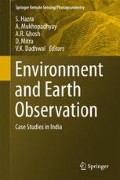Abstract
The landslide susceptibility map delineates the potential areas of landslide occurrence which is considered to be the first step for landslide hazard management. The present study focuses on the spatial analysis of landslide susceptibility in the Dhalai district using the Geographical Information System (GIS). For this purpose, landslide susceptibility maps are prepared using weight-rating and Analytical Hierarchical Processes (AHP). To analyze landslide manifestation in the present study area, different causative factors (lithology, road buffer, slope, relative relief, rainfall, fault buffer, land-use/land-cover, and drainage density) are derived as layers. The final susceptibility zonation map of weight-rating method shows that about 1.64 and 16.68 % of the total study area falls under very high and high susceptibility zones respectively. In the AHP method, the five landslide susceptibility zones are very low which accounted 14.8 % (354.35 km2) is, low 38.91 % (932.01 km2), moderate 34.75 % (832.37 km2), high 6.03 % (144.39 km2), and very high 5.51 % (131.87 km2). Both susceptibility maps show that the high susceptibility zone is restricted within the structural hilly areas and the low susceptibility zone is in the flood plain areas of the district. Both of the susceptibility maps are validated using the existing landslide distribution in the area.
Access this chapter
Tax calculation will be finalised at checkout
Purchases are for personal use only
References
Aleotti P, Chowdhury R (1999) Landslide hazard assessment: summary review and new perspectives. Bull Eng Geol Environ 58(1):21–44
Anbalagan R (1992) Landslide hazard evaluation and zonation mapping in mountainous terrain. Eng Geol 32:269–277
Belton V, Stewart T (2002) Multi criteria decision analysis: an integrated approach. Kluwaer Academic Publishers, Bostan
BIS (1998) Guideline for preparation of landslide hazard zonation maps in mountains terrains; draft proposal of the Bureau of Indian Standards 2:1–15
Brabb EE, Pampeyan, EH (1972) Preliminary map of landslide deposits in San Mateo County, California. US Geological Survey Miscellaneous Field Studies, Map MF-360, scale 1:62.500. (Reprinted in 1978)
Devi D, Das K (2013) Landslide hazard zonation along NH-39 from Kangpokpi to Mao, Manipur, India. Int J Econ Environ Geol 2(1):30–35
Dutta PJ, Sarma S (2013) Landslide susceptibility zoning of the Kala-Pahar Hill, Guwahati Assam state (India), using a GIS based heuristic technique. Int J Remote Sens Geosci 2(2):49–55
EM-DAT (2009) Emergency management disaster database. www.emdat.be/maps-disaster-types
Ermini L, Catani F, Casagli N (2005) Artificial neural networks applied to landslide susceptibility assessment. Geomorphology 66:327–343
GSI (2009) Geological survey of India report. www.portal.gsi.gov.in
Guzzetti F, Cardinali M, Reichenbach P, Carrara A (1999) Comparing landslide maps: a case study in the upper Tiber River Basin, central Italy. Environ Manag 25:247–363
Kanungo DP, Arora MK, Gupta RP, Sarkar S (2008) Landslide risk assessment using concepts of danger pixels and fuzzy set theory in Darjeeling Himalayas. Landslides 5:407–416
Kanungo DP, Arora MK, Sarkar S, Gupta RP (2006) A comparative study of conventional, ANN black box, fuzzy and combined neural and fuzzy weighting procedures for landslide susceptibility zonation in Darjeeling Himalayas. Eng Geol 85:347–366
Lallianthanga RK, Lalbiakmawia F (2013) Landslide hazard zonation of Mamit town, Mizoram, India using remote sensing and GIS techniques. Int J Geol Earth Environ Sci 3(1):184–194
Lee S (2005) Application of logistic regression model and its validation for landslide susceptibility mapping using GIS and remote sensing data. Int J Remote Sens 26:1477–1491
Pandey A, Dabral PP, Chowdary VM, Yadav NK (2008) Landslide hazard zonation using remote sensing and GIS: a case study of Dikrong river basin, Arunachal Pradesh, India. Environ Geol 54:1517–1529
Phukon P, Chetia D, Das P (2012) Landslide susceptibility assessment in the Guwahati city, Assam using analytic hierarchy process (AHP) and geographic information system (GIS). Int J Comput Appl Eng Sci 2(1):1–6
Punia M, Raman R (2012) The application of GIS-based bivariate statistical methods for landslide hazards assessment in the upper Tons river valley, Western Himalaya, India. Georisk: Assess Manag Risk Eng Syst Geo Hazards 6(3):145–161
Radbruch DH (1970) Map of relative amounts of landslides in California, US Geological Survey Open-File Report 70-1485, pp 36, map scale 1:500.000. US Geological Survey Open-File Report, 85-585
Saaty TL (1977) A scaling method for priorities in hierarchical structures. J Math Psychol 15:234–281
Saaty TL (1980) The analytical hierarchy process. McGraw Hill, NY, p 350
Saaty TL (2000) Models, methods, concepts and application of the analytical hierarchy process. Kluwer Academic Publishers, Boston
Sezer EA, Pradhan B, Gokceoglu C (2011) Manifestation of an adaptive neuro-fuzzy model on landslide susceptibility mapping: Klang valley, Malaysia. Expert Syst Appl 38:8208–8219
Singh CD, Behera KK, Rochy WS (2011) Landslide Susceptibility along NH-39 between Karong and Mao, Senapati District, Manipur. J Geol Soc India 78:559–570
Singh CD, Singh J (2013) Landslides caused due to ignorance—case studies from northeast India. J Geol Soc India 82(1):91–94
Soeters R, Van Westen CJ (1996) Slope instability recognition, analysis, and zonation. In: Urner AK, Schuster RL (eds) Landslides: investigation and mitigation, vol 247. National Academy Press, Washington, D.C, pp 129–177
Van Westen CJ, Rengers N, Soeters R (2003) Use of geomorphological information in indirect landslide susceptibility assessment. Nat Hazard 30:399–419
Author information
Authors and Affiliations
Corresponding author
Editor information
Editors and Affiliations
Rights and permissions
Copyright information
© 2017 Springer International Publishing Switzerland
About this chapter
Cite this chapter
Ghosh, K., Bandyopadhyay, S., De, S.K. (2017). A Comparative Evaluation of Weight-Rating and Analytical Hierarchical (AHP) for Landslide Susceptibility Mapping in Dhalai District, Tripura. In: Hazra, S., Mukhopadhyay, A., Ghosh, A., Mitra, D., Dadhwal, V. (eds) Environment and Earth Observation. Springer Remote Sensing/Photogrammetry. Springer, Cham. https://doi.org/10.1007/978-3-319-46010-9_12
Download citation
DOI: https://doi.org/10.1007/978-3-319-46010-9_12
Published:
Publisher Name: Springer, Cham
Print ISBN: 978-3-319-46008-6
Online ISBN: 978-3-319-46010-9
eBook Packages: Earth and Environmental ScienceEarth and Environmental Science (R0)

